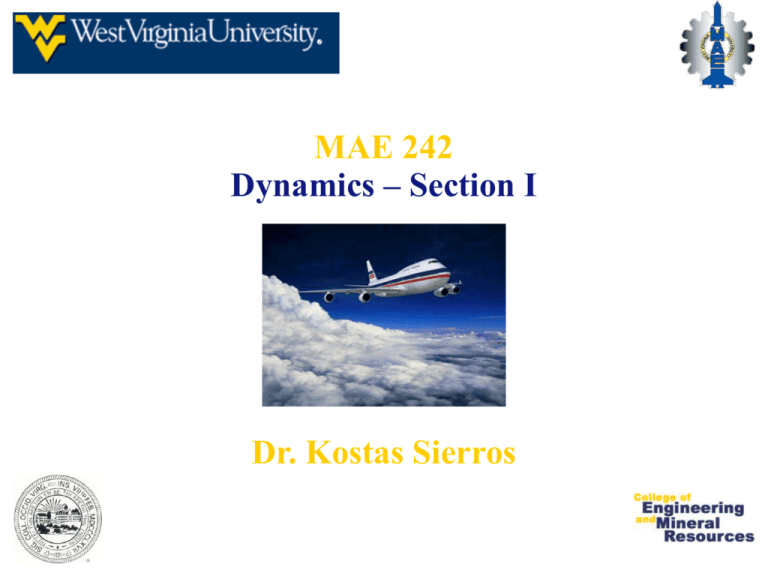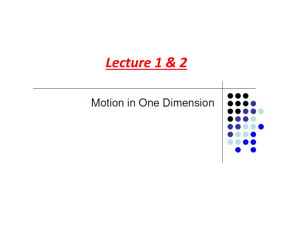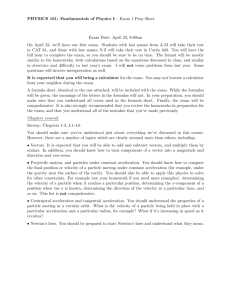Lecture 1 - Mechanical and Aerospace Engineering
advertisement

MAE 242 Dynamics – Section I Dr. Kostas Sierros Important information • MAE 242 – Section 1: Every Tuesday & Thursday 8:00-9:15 AM • All lectures will take place at 113 MRB-E • E-mail: Kostas.Sierros@mail.wvu.edu • Room: G-19 ESB • Phone: 293-3111 ext 2310 • HELP: Tuesday & Thursday 9:30-11:00 AM and by appointment Text books Engineering Mechanics: Dynamics C. Hibbeler, 11th Edition, Prentice Hall, 2006 …and probably some more… Please make sure… • You revise some maths (i.e. trigonometric identities, derivatives and integrals) • … and some STATICS… UNITS, Vector addition, FBD (Hibbeler Statics: Ch. 1,2 and 5) Revision examples (1) Revision examples (2) Revision examples (3) Kinematics of a particle: Objectives • Concepts such as position, displacement, velocity and acceleration are introduced • Study the motion of particles along a straight line. Graphical representation • Investigation of a particle motion along a curved path. Use of different coordinate systems • Analysis of dependent motion of two particles • Principles of relative motion of two particles. Use of translating axis Lecture 1 • Kinematics of a particle (Chapter 12) - 12.1-12.2 Material covered • Kinematics of a particle - Introduction - Rectilinear kinematics: Continuous motion - How to analyze problems - Problems Next lecture; Rectilinear kinematics: Erratic motion …and maybe a bit more… Kinematics of a particle: Introduction Important contributors Galileo Galilei, Newton, Euler Equilibrium of a body that is at rest/moves with constant velocity Mechanics Statics Dynamics Accelerated motion of a body • Kinematics: geometric aspects of the motion • Kinetics: Analysis of forces which cause the motion Today’s Objectives Students should be able to: 1. Find the kinematic quantities (position, displacement, velocity, and acceleration) of a particle traveling along a straight path (12.2) Next lecture; Determine position, velocity, and acceleration of a particle using graphs (12.3) Rectilinear kinematics: Continuous motion A particle travels along a straight-line path defined by the coordinate axis s The POSITION of the particle at any instant, relative to the origin, O, is defined by the position vector r, or the scalar s. Scalar s can be positive or negative. Typical units for r and s are meters (m) or feet (ft). The displacement of the particle is defined as its change in position. Vector form: r = r’ - r Scalar form: s = s’ - s The total distance traveled by the particle, sT, is a positive scalar that represents the total length of the path over which the particle travels. Velocity Velocity is a measure of the rate of change in the position of a particle. It is a vector quantity (it has both magnitude and direction). The magnitude of the velocity is called speed, with units of m/s or ft/s. The average velocity of a particle during a time interval t is vavg = r/t The instantaneous velocity is the time-derivative of position. v = dr/dt Speed is the magnitude of velocity: v = ds/dt Average speed is the total distance traveled divided by elapsed time: (vsp)avg = sT/ t Acceleration Acceleration is the rate of change in the velocity of a particle. It is a vector quantity. Typical units are m/s2 or ft/s2. The instantaneous acceleration is the time derivative of velocity. Vector form: a = dv/dt Scalar form: a = dv/dt = d2s/dt2 Acceleration can be positive (speed increasing) or negative (speed decreasing). As the book indicates, the derivative equations for velocity and acceleration can be manipulated to get a ds = v dv Constant acceleration The three kinematic equations can be integrated for the special case when acceleration is constant (a = ac) to obtain very useful equations. A common example of constant acceleration is gravity; i.e., a body freely falling toward earth. In this case, ac = g = 9.81 m/s2 = 32.2 ft/s2 downward. These equations are: v t dv = a dt c vo o s t ds = v dt so v v = vo + act yields s = s o + v ot + (1/2)a ct 2 yields v2 = (vo )2 + 2ac(s - so) o s v dv = ac ds vo yields so Important points • Dynamics: Accelerated motion of bodies • Kinematics: Geometry of motion • Average speed and average velocity • Rectilinear kinematics or straightline motion • Acceleration is negative when particle is slowing down • α ds = v dv; relation of acceleration, velocity, displacement Analyzing problems in dynamics Coordinate system • Establish a position coordinate S along the path and specify its fixed origin and positive direction • Motion is along a straight line and therefore s, v and α can be represented as algebraic scalars • Use an arrow alongside each kinematic equation in order to indicate positive sense of each scalar Kinematic equations • If any two of α, v, s and t are related, then a third variable can be obtained using one of the kinematic equations • When performing integration, position and velocity must be known at a given instant (…so the constants or limits can be evaluated) • Some equations must be used only when a is constant Problem solving MUSTS 1. Read the problem carefully (and read it again) 2. Physical situation and theory link 3. Draw diagrams and tabulate problem data 4. Coordinate system!!! 5. Solve equations and be careful with units 6. Be critical. A mass of an aeroplane can not be 50 g 7. Read the problem carefully Problem 1 Problem 2 Problem 3






